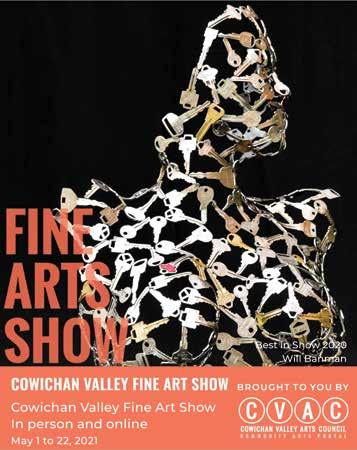
9 minute read
Sunrise Waldorf School Open House
For over 40 years, Sunrise Waldorf School has drawn families from British Columbia, throughout Canada, and around the world, who are looking for a wholistic lifestyle and education for their children. Our beautiful seven acre campus, located in Cowichan Station, allows for endless opportunities for learning and living in harmony with nature.
Early Childhood Education at Sunrise school begins at ages 3 - 5 in the preschool and ages 5 - 6 in the Kindergartens. These classrooms are known for their warm and nurturing environment. Soft colours and natural materials encourage creative play, and a reliable rhythm of activities each day, offer abundant time to play with joy and confidence. The immense care and expertise of our teachers give the children a strong sense of belonging and safety.
Advertisement
Sunrise Waldorf School Early Childhood students spend a great deal of time each day outside, in rain or shine, and in open ended imaginative play. Foundations for grade school learning are developed with activities that focus on listening to language, clear speech, fine motor skills, eye hand coordination, and deep imaginative play. It is through play and movement, that our youngest students receive the foundations needed for grade school readiness and a love of learning.
The elementary and middle school at Sunrise is a place of academic excellence, coupled with a strong special subject program which includes, physical and health education, woodworking, music and string instruments, handwork, and French as a second language. A Waldorf education is one that meets the whole human being, and is imbued with beauty, and care. All subjects are taught in combination with movement, art, and meaning for the child. This translates into enthusiastic and engaged students who love to learn, and who are reassured in knowing themselves. In the grade school, observational, problem solving, creative and critical thinking skills are developed and nurtured through a curriculum designed to meet the student where they are at developmentally.
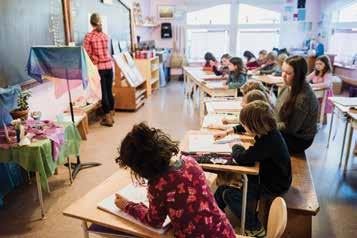
Festivals and seasons are marked throughout the year offering a sense of belonging, and reverence for our natural surroundings. These yearly traditions are also a way that our community comes together to celebrate and share with common values and connection. Sunrise Waldorf School is a place of learning and growth for the whole family.
Our teachers are passionate and committed to their role in raising future citizens. Through Waldorf Education philosophies and curriculum, our faculty members bring wonder and depth to the classroom. They inspire our students and build in them a sense of curiosity about the people and world around them.
To learn more about our school and Waldorf Education, or to schedule a visit to our campus, please contact admissions@ sunrisewaldorfschool.org. We look forward to meeting you and to welcoming you to our school and community. www.sunrisewaldorfschool.org
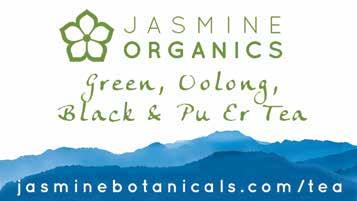
THE GLENORA STORE & CAFE IS A LOCAL CORNERSTORE WITH A TWIST! Stocked with basic groceries and produce.
The cafe offers fresh baked goods, hot lunch specials, drinks, and snacks. We also sell hand-woven products, beeswax candles, and prepared herbs from Glenora Farm Outdoor heated seating 5090 Indian Road (corner of Glenora Rd & Indian Rd)
250-746-5313 I www.glenorafarm.org
“ Sol-Centre & The Freya-Sophia Waldorf Store ~ A Community Farm Store Initiative ”
Balance Discs, Balance Bikes, Trikes, Cargo Carriers, Birdhouse Kits, Push and Pull Toys and more from

Findus, Food and Fun is for mums, dads, grandparents, teachers, childminders, aunts, uncles and anyone who knows a young child who is curious about the world. Together with Findus, Pettson and the muckles, this amazing activity book is filled with things to do or make for every season; pottering, collecting, fixing, crafting, building, exploring, baking. Sometimes outdoors, sometimes indoors, it’s a whole year’s worth of ideas. The award winning Findus series has 13 books in total, filled with bright illustrations and lively, lovable characters.
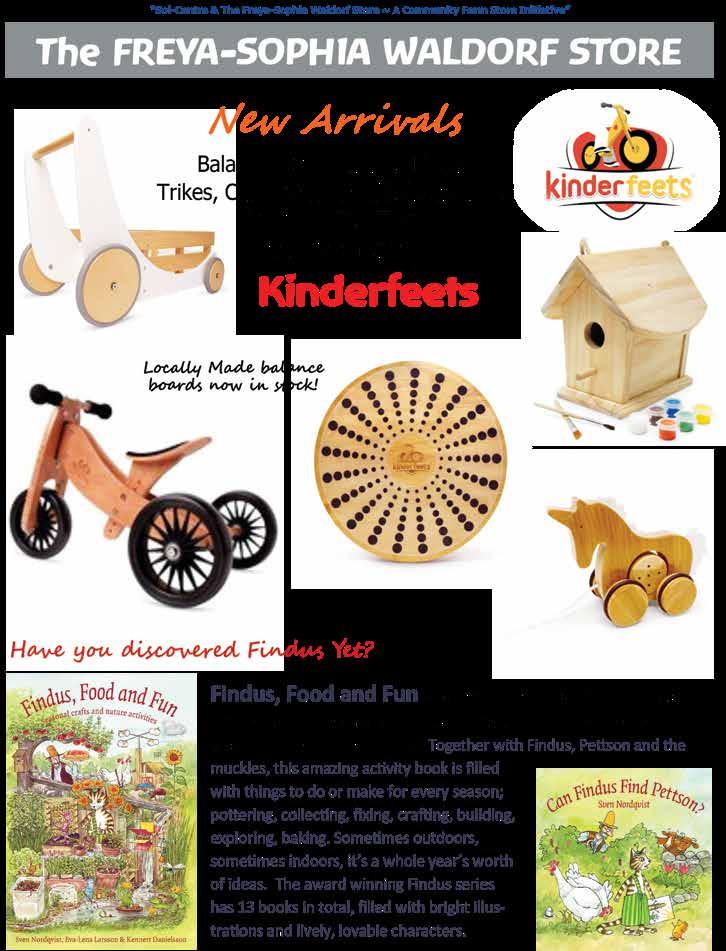
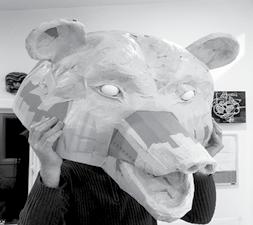
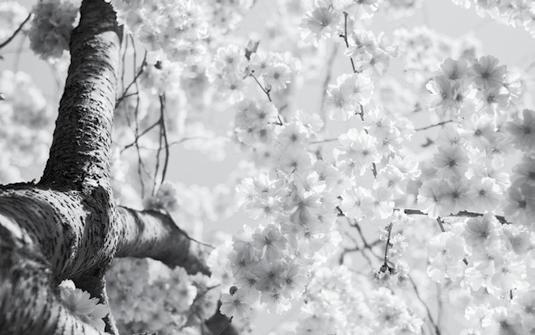
PARADE PUPPETS, ONLINE DEMONSTRATION
Large format puppets can be a dynamic part of your performance or outdoor community event. They are also a fun activity to do with your kids or a student project. In this 90-minute workshop, Heather Kent will demonstrate how you can build simple parade puppets at home using easy to find materials. You will learn: wonders and art of a parade, a few basic designs, materials and methods for building parade puppets, and some basic manipulation. For ages 12 and up, parents and children together and teachers. Cowichan Valley Arts Council. April 19, 1-2:30 pm Parade Puppets, Online demonstration For details email manager@ cowichanvalleyartscouncil.ca Cost: $20.
Silvia Graber is a Registered Nutritionist and Functional Medicine Practitioner specializing in digestion and mental health.
Finally its Spring! The time of flowers, freshly mowed grass, birds chirping and lots of tissue. No, not because it makes you so happy you cry, but because you may be one of many who suffer with seasonal allergies at this time of year. Warmer weather can come with uncomfortable symptoms for some people, which can include runny noses, headaches, sneezing, wheezing, congestion, and rashes. Environmental allergies are an immune response from your body when exposed to certain elements in the environment such as pollen, dust, chemicals,or pet dander. The body can over-react to these elements, seeing them as “enemies”, and can provoke an inflammatory response in the body. Many people reach for anti-histamines or medications, which can work by suppressing the release of histamine in the body, preventing an allergic response. While these can be effective in the short-term, I would like to see allergies being dealt with in a more holistic way, namely by addressing the root causes and working to re-balance the immune response in the body. Here are a few tips to get you started: 1. Gut health - Addressing allergies means going to where the immune response begins, which is largely in the gut. Leaky gut is a condition that arises with inflammation in the gut barrier, causing particles to enter the bloodstream, leading to allergic responses, which can occur throughout the body. Reduce inflammation by chewing your food well, avoiding toxins and chemicals in food, and addressing insufficient stomach acid. Support your body continuously with nutritious foods and good digestion, and it just might respond by calming down and not overreacting to its environment.
Release trapped emotions Resolve sleep problems Manage stress and pain Achieve self-confidence 250-597-3686 First appointment free! David Yaeger
Emotion Code Body Code and Quantum Touch davidyaeger650@gmail.com
https://discoverhealing.com/practitioner-map/ (fi nd me in Duncan)
A Natural Approach To Seasonal Allergies
regularly. Take Vitamin C daily, which is a natural anti-histamine. Manage your stress.
3. Eat stinging nettle - This so-called weed many people try to avoid is actually one of the most nutritious and bloodbuilding plants you can have in your diet. Many studies have also suggested nettle can be effective as a natural anti-inflammatory and antihistamine medicinal plant, which can help to reduce the allergic response.
I hope some of these suggestions help you to enjoy the season, with less suffering, and more smiles!
2. Support your immune system - The stronger and more balanced your immune system, the less it will be affected by its environment. Eat a whole foods, antioxidant, nutrient-rich diet. Drink lots of water. Exercise You can book a consultation with Silvia at sageheartnutrition@gmail. com or visit her website at sageheartnutrition.wordpress. com


1-778-554-5434 I tarynogormandesigns.com
Let the Pollinating Begin
John Magdanz. A Cowichan Valley beekeeper
Did you know that one out of every three bites of food that you eat is reliant on a plant being pollinated.
Plants rely on bees and other insects to help with pollination. Pollination is the plants way to reproduce. Most plants are not able to pollinate themselves so they rely on another plant from the same family. The bees and insects are attracted to the plants by colour, odor and taste. They create a symbiotic relationship where they both benefit. The plants get pollinated so they can reproduce and the bees and insects are fed.
A great example is the apple tree which relies on another apple tree for propagation. For propagation to take place the pollen from another tree is needed for reproduction. The apple is the result which produces seeds. This is why when you buy a fruit tree it is advised that you buy more than one of the same species unless your neighbour has a tree of the same species.
Last year in the Cowichan Valley there were very few plums but the previous year there were lots. This was because last year it was cold when the plum trees were blooming and the bees were not flying so there was very little pollination. Weather is a determining factor for pollination but so are things such as insecticides, pesticides and herbicides which kill bees and other insects.
The vegetables in our gardens and the wild plants are no different. Some don’t need pollination to grow like onions, but they need pollination to produce seeds to produce new onions. Others like squashes need to be pollinated in order to produce the vegetable.
As we can see bees and insects are very important. Without them we would loose most of our food resources. While honeybees are great
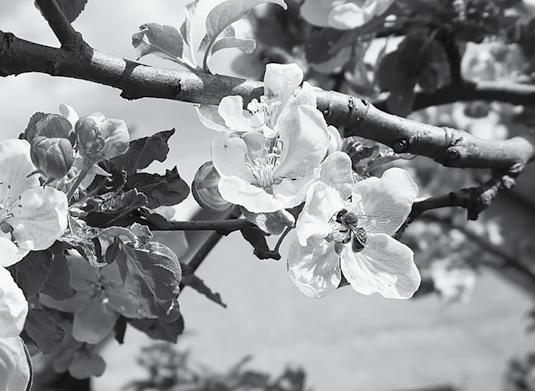
Find us at the Duncan Farmer’s Market on Saturdays!
Charcuterie, Grazing Boxes and Entertaining Ideas www.picklespantry.ca I 250-266-2464 250-266-2464
pollinators, the native bees do a much better job of pollinating native plants. For example, it was found that bumble bees did a better job of pollinating blueberries than honeybees. One reason for this could be that bumble bees can withstand colder weather and blueberries flower in the early spring.
Another thing to remember is that not all plants are food resources for bees. This is why seed catalogues point out the ones which are. It is also important to conserve some land in its native state for the wild bees. Many of these nest in the ground or tree cavities.
A couple of years ago I planted buckwheat between my rows of potatoes after hilling. I was amazed at how many species of wild bees were attracted to the buckwheat flowers as well as honeybees. Last year I planted sunflowers and had the same result. This year I am planning to plant sunflowers and okra.
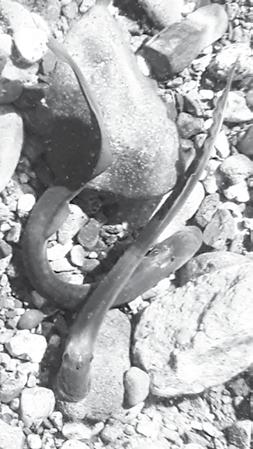
APRIL 20 7PM Cowichan Lake Lamprey: Our Local Wonder by Genevieve Singleton
Cowichan Lake lamprey is a parasitic fish species found only in Mesachie, Cowichan and Bear lakes; nowhere else in the world! They became a federally protected Threatened species in 2003. To learn about their fascinating world and what you can do to protect this species and its habitat, join the Cowichan Valley Naturalists’ zoom presentation by Genevieve Singleton, 7 pm April 20th. Email cvns@naturecowichan. net for link. Everyone Welcome.
ACUPUNCTURE MASSAGE THERAPY HERBAL MEDICINE
Online Booking & Direct Billing www.pestleandpins.com
DR. KEVIN IANSON, Dr.TCM (R.Ac)
AMANDA KNAPP, R.TCM.P (R.AC) CHELSEA RANEY, R.TCM.P (R.AC) EVAN MONCRIEFF, RMT DR. BREWSTER SCOTT, ND, R.TCM.P
4705 Trans Canada Hwy I 250-889-9066 I Whippletree Junction 59



